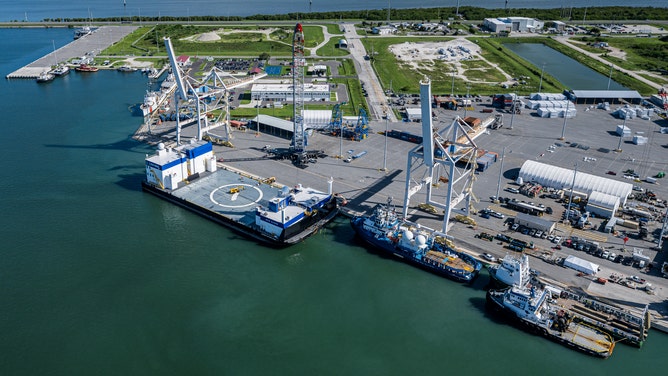Blue Origin’s landing ship arrives in Florida ahead of first New Glenn rocket launch
Blue Origin and NASA are targeting no earlier than Oct. 13 for New Glenn to launch NASA's ESCAPADE spacecraft to Mars. After liftoff, Blue Origin hopes to land the 188-foot-tall rocket booster on an autonomous ship in the Atlantic.
Meet Blue Origin's marine landing vessel, Jacklyn
Blue Origin's marine landing vessel is where the company plans to land the New Glenn rocket booster after launch. The booster will then be refurbished to launch again and again.
Blue Origin is preparing to launch its heavy-lift rocket, New Glenn, and land it for the first time from Florida's Space Coast this fall.
The company, founded by Jeff Bezos, will launch a NASA spacecraft to Mars in the inaugural launch of New Glenn. NASA and Blue Origin are targeting Sunday, Oct. 13, to launch NASA's ESCAPADE spacecraft from Cape Canaveral Space Force Station Launch Complex 36.
The spacecraft, which stands for Escape and Plasma Acceleration and Dynamics Explorers, will study space weather around Mars and how the planet's atmosphere continues to escape. Rocket Lab built the spacecraft, which arrived in Florida in August and will soon be integrated with the New Glenn rocket for liftoff this fall.
Blue Origin has been developing the New Glenn rocket and its BE-4 rocket engines for years. The rocket was named after the late NASA astronaut John Glenn, the first American to orbit the Earth.
New ship in town: Landing vessel Jacklyn arrives in Florida
The signs that Blue Origin is getting closer to launch are happening quickly at Cape Canaveral Space Force Base and Port Canaveral.
On Tuesday, Blue Origin’s marine landing platform, "Jacklyn," sailed through the jetty at Port Canaveral and docked ahead of the first launch and landing attempt.
The ship is autonomous, and no one will be onboard Jacklyn when the New Glenn booster returns for landing. The company’s feather logo is at the ship's center, marking the spot where engineers hope the booster will softly touch down.

Blue Origin's landing ship Jacklyn docks at Port Canaveral ahead of the first New Glenn rocket launch this fall. Photo taken on Sept. 4, 2024.
Blue Origin’s smaller reusable rocket, New Shepard, has been launching science payloads from Texas since 2015 and short-duration human spaceflights to the edge of space since 2021.
Both New Shepard and New Glenn are reusable rockets. New Shepard has repeatedly made landings in the Texas desert near Van Horn, but New Glenn will make its booster landings at sea off the coast of Florida.
Blue Origin CEO Dave Limp said that even though New Glenn’s first-stage booster is 188 feet tall compared to New Shepard’s 54-foot booster, the landing zone on the vessel is the same 20-foot diameter as the landing pad for the smaller rocket.
"This comes down to physics — it’s easier to balance a broom on your palm rather than a pencil because the broom has a higher center of mass," Limp wrote on X, formerly Twitter.
The company plans to attempt the first New Glenn landing after the first launch. Like all things in spaceflight development, a landing on the first try would be impressive, but failure is also possible as the company works out kinks using this new rocket and landing platform.
"We hope to stick the landing on our first New Glenn launch — but if we’re not successful, we’ll learn, and keep trying until we do," Limp said.
Blue Origin aims to use each New Glenn booster for at least 25 flights.
